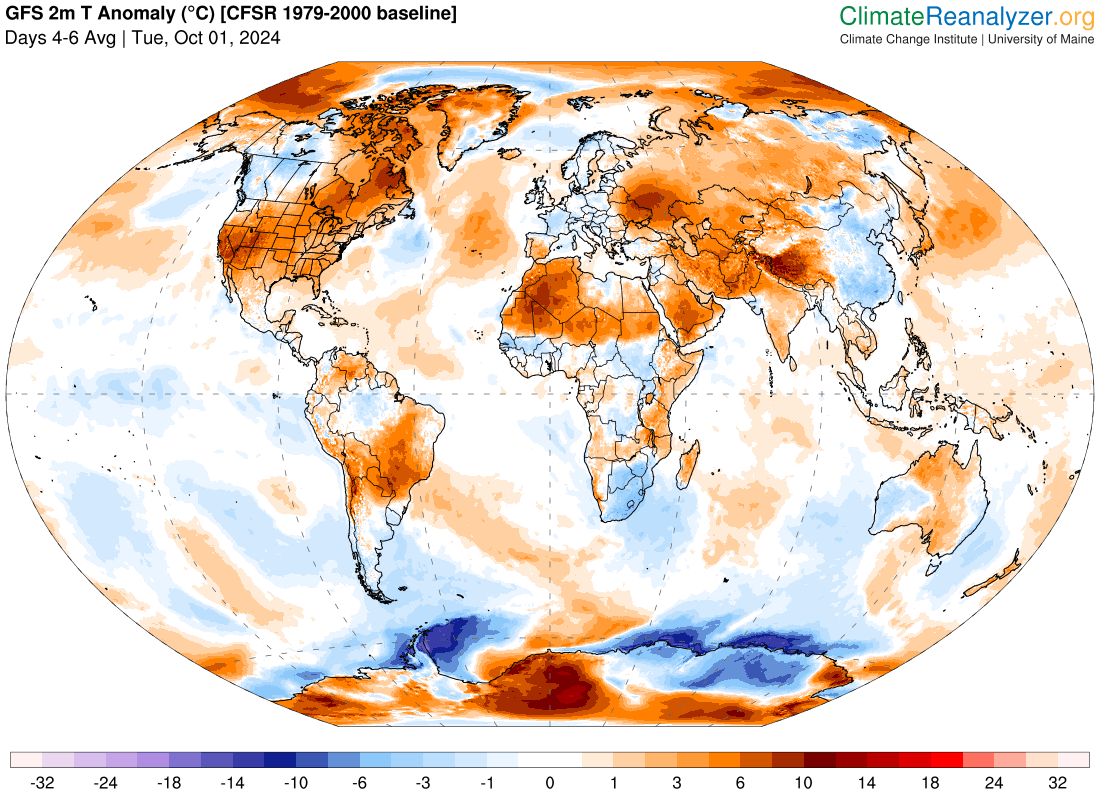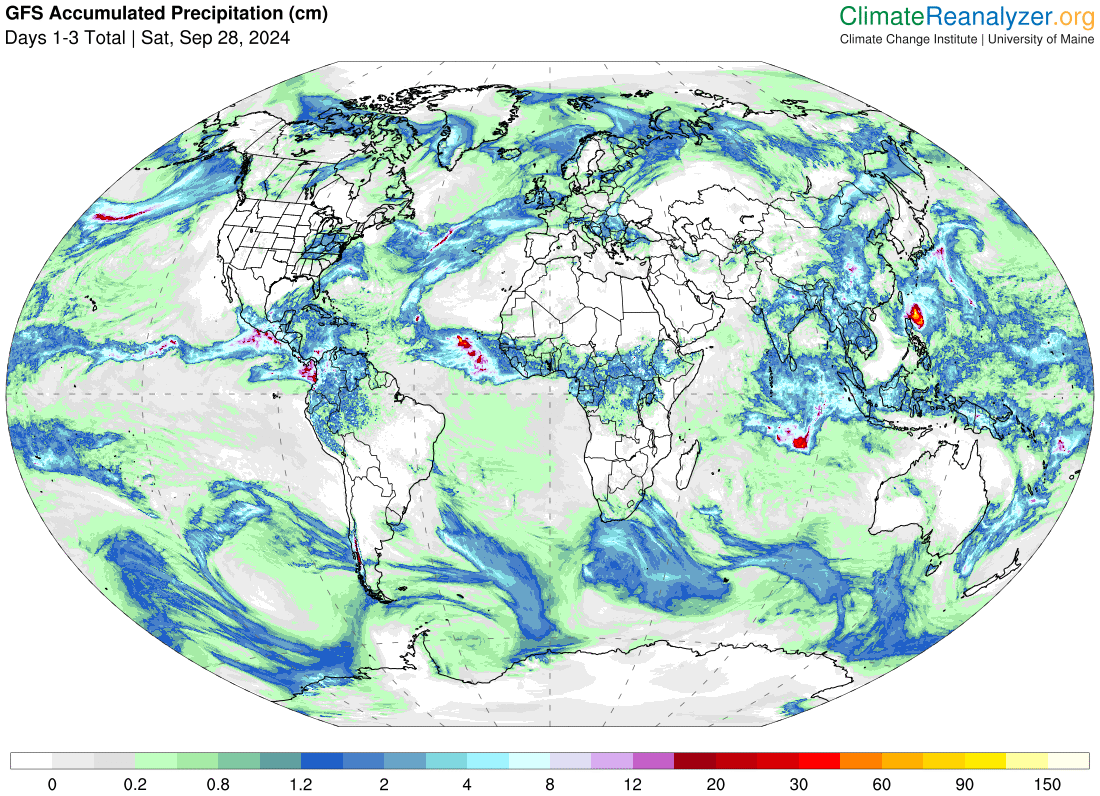Here is what we are paying attention to in the next 48 to 72 hours. The article also includes weather maps for longer-term outlooks and a six-day World weather outlook.
We start with the U.S. Information. You can update this section here but these are 48 to 72-hour forecasts so if I have not been able to update this area twice daily, what is shown is still valid and the images in the body of the article update automatically but sometimes they are a bit slow to update.
Short Range Forecast Discussion
NWS Weather Prediction Center College Park MD
Wed Sep 20 2023
Valid 12Z Wed Sep 20 2023 – 12Z Fri Sep 22 2023…Much cooler, Fall-like temperatures and locally heavy rainfall for the
West……Above average heat forecast from the Plains to the Great Lakes through
Thursday……Chances for heavy rain and severe thunderstorms continue for the
Southern Plains…
| Notices: We recently published the ENSO Alert Update and you can access that report HERE. |
First, the 48-Hour Forecast (It is a 48 to 72 Hour Forecast actually)
Daily weather maps. The Day 1 map updates twice a day and the Day 2 and 3 maps update only once a day. These maps update automatically. But if that does not happen, you can get updates by clicking HERE
TODAY (or late in the day the evening/overnight map will appear)
TOMORROW
NEXT DAY
This animation shows how things may play out over the next 60 hours. To update click here.
The NWS Climate Prediction Center’s: Watches, Warnings, and Advisories plus other information can be found HERE. We post at least one of those updates daily, sometimes both. The Highlights are shown in the lede paragraph of this article.
ATMOSPHERIC RIVERS
This tells us what is approaching the West Coast. Click HERE to update If I have not gotten around to doing the update. Here is some useful information about Atmospheric Rivers.
Continuation of the NWS Short Range Forecast. It is updated by NWS twice a day and these updates can be found here
A deep upper-level low dropping southward over the West from Canada will
provide quite the cool down over the next couple of days. The low will
help to drive a quasi-stationary front lingering over the Intermountain
West further southward, bringing much below average, Fall-like
temperatures. Highs in the upper 50s and low 60s in the Pacific Northwest
and Northern Rockies on Wednesday will spread into the Great Basin by
Thursday. Highs along the Pacific Coast will be much below average too,
with 60s into Southern California. Conditions will remain a bit more
seasonable in the Desert Southwest, with mostly 90s expected. In addition
to the cooler temperatures, enhanced lift from the approaching upper-low
as well as moisture pooling along and behind the frontal boundary will
lead to increasing shower and thunderstorm chances across the
Intermountain West Wednesday into Thursday. Some more widespread, locally
heavy rainfall and increasingly wet antecedent conditions may lead to a
higher risk for an isolated chance of flash flooding for portions of the
Great Basin into the Northern Rockies on Thursday.To the east, much above average temperatures will continue for the Plains
and spread into the Great Lakes as an amplifying pattern helps to
reinvigorate upper-level ridging over the central U.S. Forecast highs in
the upper 70s to mid-80s will be 10-20 degrees above average for portions
of the Northern Plains/Upper Great Lakes. Highs in the mid- to upper 90s
in Texas are similarly above average for late Summer. While not quite as
anomalous, highs in the mid- to upper 80s for locations in the Central and
Southern Plains are still quite warm. Meanwhile, thunderstorm chances will
continue along a lingering quasi-stationary front draped from the Southern
Plains into the Lower Mississippi Valley Wednesday into Thursday with both
locally heavy rainfall and some instances of damaging winds/large hail
possible. An upper-level shortwave approaching the region later Thursday
should help to enhance storm development/coverage, leading to a higher
risk of more widespread heavy rainfall and some scattered instances of
flash flooding for portions of southeastern Oklahoma into northeastern
Texas, with a Slight Risk of Excessive Rainfall (level 2/4) in place.
Increasing lift ahead of the deepening upper-low over the West should lead
to increased shower and thunderstorm chances along a quasi-stationary
front over the Northern Plains Thursday with some locally heavy rainfall
possible here as well.Elsewhere, conditions will remain relatively dry with seasonable
temperatures for most of the eastern U.S. Forecast highs Wednesday and
Thursday will be in the 60s and 70s for New England, 70s and 80s for the
Mid-Atlantic, and 80s for the Southeast into Florida. A lingering frontal
boundary over the Florida Peninsula will continue to lead to daily
thunderstorm chances, with some locally heavy downpours and isolated flash
flooding possible. Rain chances may begin to increase late Thursday
northward along the Georgia and Carolina coasts as an area of low
pressure/frontal system begins to organize just off the coast.
Learn about wave patterns HERE.
Below is the current five-day cumulative forecast of precipitation (Updates can be found HERE)
Now we look at Intermediate-Term “Outlook” maps for three time periods. Days 6 – 10, Days 8 – 14, and Weeks 3 and 4. An outlook differs from a forecast based on how NOAA uses these terms in that an “outlook” presents information as deviation from normal and the likelihood of these deviations.
Below are the links to obtain updates and additional information. They are particularly useful if you happen to be reading this article significantly later than when it was published. I always try to provide readers with the source of the information in my articles.
| Days 6 – 10 (shown in Row 1) | Days 8 – 14 (Shown in Row 2) | Weeks 3 and 4 (Shown in Row 3 but updates only on Fridays) |
| https://www.cpc.ncep.noaa. gov/products/predictions/610day/ | https://www.cpc.ncep .noaa.gov/products/predictions/814day/ | https://www.cpc.ncep.noaa.gov/products/predictions/WK34/ |
Showing the actual maps. They should now update automatically. The Week 3 – 4 Outlook only updates on Fridays. So below is what I call the Intermediate-term outlook. On Fridays, it extends out 28 Days. That declines day by day so on Thursday it only looks out 22 days until the next day when the Week 3 – 4 Outlook is updated and this extends the outlook by one additional week.
| 6–
10
|
|
|
| 8–
14 |
|
|
| 3–
4 |
|
|
HAZARDS OUTLOOKS
Click here for the latest complete Day 3 -7 Hazards forecast which updates only on weekdays. Once a week probably Monday or Tuesday I will update the images. I provided the link for readers to get daily updates on weekdays. Use your own judgment to decide if you need to update these images. I update almost all the images Friday Night for the weekend edition of this Weather Report. So normally readers do not need to update these images but if the weather is changing quickly you may want to.
Temperature month to date can be found at https://hprcc.unl.edu/products/maps/acis/MonthTDeptUS.png
Precipitation month to date can be found at https://hprcc.unl.edu/products/maps/acis /MonthPNormUS.png
World Forecast
Below are the Day 1 -3 and 4-6 forecasts for temperature and precipitation. Updates and much additional information can be obtained HERE
World Temperature Anomalies

World Accumulated Precipitation

This information is provided by the University of Maine. They draw upon many different sources. There is a lot of information available at the link provided. I have just provided two useful forecasts. There are probably over a hundred different forecasts available from this source.
Worldwide Tropical Forecast (This is a NOAA Product)
This graphic updates on Tuesdays) If it has not been updated, you can get the update by clicking here Readers will only have to do that if they are reading this article much later than the date of it being published.
Information on Tropical Storms can be found HERE. Western Pacific information can be found HERE.

–
| I hope you found this article interesting and useful. |
–



